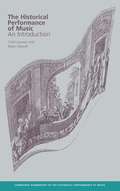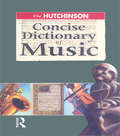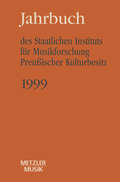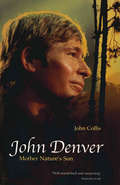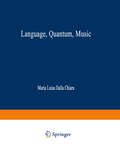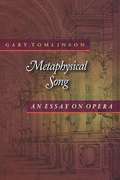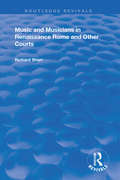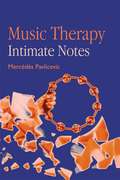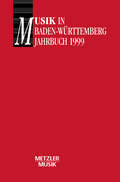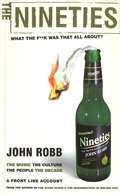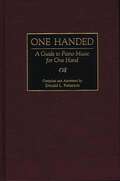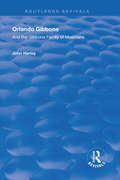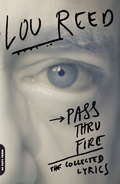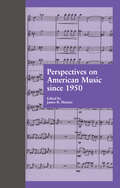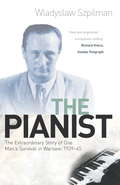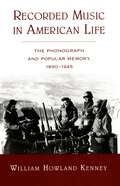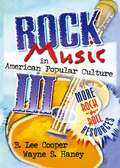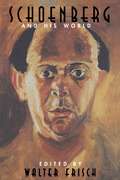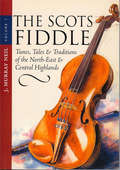- Table View
- List View
The Historical Performance Of Music: An Introduction (Cambridge Handbooks To The Historical Performance Of Music Ser. (PDF))
by Colin J. Lawson Robin StowellOffering students and performers a concise overview of historical performance, this 1999 book takes into account the many significant developments in the discipline. It addresses practical matters rather than philosophical issues and guides readers towards further investigation and interpretation of the evidence provided, not only in the various early instrumental and vocal treatises, but also in examples from the mainstream repertory. Designed as a parent volume for the series Cambridge Handbooks to the Historical Performance of Music, this book provides an historical basis for artistic decision-making which has as its goal the re-creation of performances as close as possible to the composer's original conception. It relates many of the issues discussed to major works by Bach, Mozart, Berlioz and Brahms, composed c.1700–c.1900, the core period which forms the principal (though not exclusive) focus for the whole series.
The Hutchinson Concise Dictionary of Music (Helicon Arts And Music Ser.)
by Barrie JonesFirst Published in 1999. Routledge is an imprint of Taylor & Francis, an informa company.
The Hutchinson Concise Dictionary of Music
by Barrie JonesFirst Published in 1999. Routledge is an imprint of Taylor & Francis, an informa company.
Jahrbuch des Staatlichen Instituts für Musikforschung (SIM) Preußischer Kulturbesitz: 1997
Das Jahrbuch 1999 hat drei inhaltliche Schwerpunkte: die Musik der Bach-Zeit, Formkategorien in Instrumentalwerken des Fin de Siècle und der Neuen Musik sowie die instrumentenkundliche Forschung des Instituts.
John Denver: Mother Nature's Son
by John CollisJohn Denver was America's biggest-selling solo star of the '70s. In commercial terms he was on a par with Sinatra in the '40s, Elvis in the '50s and the Beatles in the '60s. He experimented with a variety of styles and won fans from such diverse worlds as folk, pop and country music. Beneath the often tranquil surface of his music and his clear, clean tenor voice, however, lurked a darker side to Denver's character. The writer of 'Annie's Song', one of the most straightforward and personal expressions of love, became a wife-beater. The man who cavorted with the Muppets was an alcoholic. The committed environmentalist had his own plane, the most polluting form of transport. John Collis has delved deep to discover exactly who John Denver was. By unravelling the complexities of the singer's personality and background, he reveals Denver as a complicated, contradictory man, much more intriguing than the sometimes placid surface of his music might suggest. Millions of people around the globe found something in his music that touched their souls; Collis, by charting Denver's career and development as an artist, explores his legendary contribution not only to the world of music but also to the society of which he was a protagonist and a victim.
Language, Quantum, Music (Synthese Library #281)
by Maria Luisa Dalla Chiara Roberto Giuntini Federico LaudisaA vivid and comprehensive picture of the current state of research in all directions of logic and philosophy of science. The book presents a wide combination of papers containing relevant technical results in the foundations of science and papers devoted to conceptual analyses, deeply rooted in advanced present-day research. Audience: The volume is attractive both for specialists in foundational questions and scholars interested in general epistemology.
Metaphysical Song: An Essay on Opera
by Gary TomlinsonIn this bold recasting of operatic history, Gary Tomlinson connects opera to shifting visions of metaphysics and selfhood across the last four hundred years. The operatic voice, he maintains, has always acted to open invisible, supersensible realms to the perceptions of its listeners. In doing so, it has articulated changing relations between the self and metaphysics. Tomlinson examines these relations as they have been described by philosophers from Ficino through Descartes, Kant, and Nietzsche, to Adorno, all of whom worked to define the subject's place in both material and metaphysical realms. The author then shows how opera, in its own cultural arena, distinct from philosophy, has repeatedly brought to the stage these changing relations of the subject to the particular metaphysics it presumes. Covering composers from Jacopo Peri to Wagner, from Lully to Verdi, and from Mozart to Britten, Metaphysical Song details interactions of song, words, drama, and sounds used by creators of opera to fill in the outlines of the subjectivities they envisioned. The book offers deep-seated explanations for opera's enduring fascination in European elite culture and suggests some of the profound difficulties that have unsettled this fascination since the time of Wagner.
Music and Musicians in Renaissance Rome and Other Courts (Routledge Revivals)
by Richard SherrFirst published in 1999, the essays that follow have been selected from the author’s writings to explore musical institutions in 15th and 16th century Italy with a detailed focus on the papal choir, but with additional comments on Mantua (Mantova), Florence and France. Much of the material which formed the basis of those essays was largely drawn from archives. Richard Sherr explores diverse areas including the Medici coat of arms in a motet for Leo X, performance practice in the papal chapel during the 16th century, the publications of Guglielmo Gonzaga, Lorenzo de’ Medici as a patron of music and homosexuality in late sixteenth-century Italy.
Music and Musicians in Renaissance Rome and Other Courts (Routledge Revivals)
by Richard SherrFirst published in 1999, the essays that follow have been selected from the author’s writings to explore musical institutions in 15th and 16th century Italy with a detailed focus on the papal choir, but with additional comments on Mantua (Mantova), Florence and France. Much of the material which formed the basis of those essays was largely drawn from archives. Richard Sherr explores diverse areas including the Medici coat of arms in a motet for Leo X, performance practice in the papal chapel during the 16th century, the publications of Guglielmo Gonzaga, Lorenzo de’ Medici as a patron of music and homosexuality in late sixteenth-century Italy.
Music Therapy: Intimate Notes
by Mercedes PavlicevicThe stories and reflections in this book describe powerful encounters between nine music therapists and their clients. These clients include four-year-old Giorgios, who is terminally ill; Wendy, a passionate, battered child who has been rejected by her mother; Olive, suffering from senile dementia; Martha, whose successful life is in crisis; and Steve, who is living with HIV/AIDS. Through music therapy the clients - and therapists - discover their creativity, and, in the process, come to terms with suffering. The stories reveal the passion and integrity of nine music therapists who themselves undergo profound changes as a result of their work. Music Therapy - Intimate Notes is a practical and inspiring introduction to music therapy, showing its range of possibilities in various settings. The book provides a lively and informal theoretical foundation, and connects music to our intimate lives.
Musik in Baden-Württemberg: Jahrbuch 1999 / Band 6
by Gesellschaft für Musikgeschichte in Baden-WürttembergIm Mittelpunkt des diesjährigen Jahrbuchs stehen Editionsprobleme am Beispiel der »Denkmäler der Musik in Baden-Württemberg« (Petrus Eder, Manfred Hermann Schmidt, Andreas Traub, Bernhard Mosbauer).
The Nineties: What the F**ck Was That All About?
by John RobbIF YOU REMEMBER THE NINETIES...YOU WERE THERE!The Rock 'N' Roll Fifties. The Swinging Sixties. The trashy Seventies. The money-grabbing Eighties. There is a neat bunch of clichés for every era, but THE NINETIES...What the f**k was that all about?John Robb takes us on a personal odyssey through the definitive pop cultural moments that shaped the decade in the UK.
One Handed: A Guide to Piano Music for One Hand (Music Reference Collection)
by Donald PattersonThis guide to the piano literature for the one-handed pianist surveys over 2,100 individual piano pieces which include not only concert literature but pedagogical pieces as well. Following the introduction are four chapters cataloguing original works for the right hand alone, original works for the left hand alone, music arranged or transcribed for one hand alone, and concerted works for one hand in concert with other pianists, instruments, or voices. Each entry assesses the individual composition, its quality, its difficulty, its particular appeal, and its uses with the composer's name, dates, and nationality, where possible. Also included is a selected discography of commercially produced phonodiscs, compact discs, and cassettes.Instructors and pianists alike will appreciate this exhaustive guide to one-handed piano music. To aid further research, a bibliography of books, articles, and theses about the literature is provided along with a chapter that lists the contents of thirty-six anthologies devoted to one-handed piano music. This unique reference also includes an index.
Orlando Gibbons and the Gibbons Family of Musicians (Routledge Revivals)
by John HarleyFirst published in 1999, this volume is the first full-length study to deal with the life and music of Orlando Gibbons since E.H. Fellowes’s short book, originally published in 1923. John Harley investigates in detail the family and musical background from which Orlando Gibbons emerged, and gives a fascinating account of the activities of his father, William Gibbons, as a wait in Oxford and Cambridge. He traces, too, the activities of Orlando’s brothers – Edward, who was the master of the choristers at King’s College, Cambridge and later at Exeter Cathedral; Ferdinando, who may have taken over from his father as head of the Cambridge waits, and who became a wait in Lincoln; and Ellis, who contributed two madrigals to Thomas Morley’s collection of 1601, The Triumphs of Oriana. Attention naturally focuses principally on Orlando Gibbons. A full record is given of his remarkably youthful appointment as an organist of the Chapel Royal (he was probably less than twenty at the time) and of his life at court. His additional appointments as one of Prince Charles’s musicians and as organist of Westminster Abbey are also described, as is his sudden and premature death in his early forties. Gibbons’s music is carefully examined in a series of chapters dealing with his pieces for keyboard and for viols, his songs, his full and verse anthems, and his works for the Anglican liturgy. His development as a composer within these genres is followed, and the character of particular pieces is considered. John Harley concludes that whereas, at one time, Gibbons ‘tended to be admired as a successor to Tallis and Byrd, working in a style not essentially different from theirs’, it is now ‘easier to view him as a pioneer, whose work was cut short by his untimely death’. Orlando Gibbons’s son Christopher was only a child when his father died, but he became one of the foremost composers and keyboard players of his generation, writing and performing chamber works and music for the stage during the Commonwealth. Following the Restoration of King Charles II, Christopher Gibbons gained his father’s former posts at the Chapel Royal and Westminster Abbey, for which establishments he wrote a number of anthems. His importance is recognized by the inclusion of a long chapter on his life and works.
Orlando Gibbons and the Gibbons Family of Musicians (Routledge Revivals)
by John HarleyFirst published in 1999, this volume is the first full-length study to deal with the life and music of Orlando Gibbons since E.H. Fellowes’s short book, originally published in 1923. John Harley investigates in detail the family and musical background from which Orlando Gibbons emerged, and gives a fascinating account of the activities of his father, William Gibbons, as a wait in Oxford and Cambridge. He traces, too, the activities of Orlando’s brothers – Edward, who was the master of the choristers at King’s College, Cambridge and later at Exeter Cathedral; Ferdinando, who may have taken over from his father as head of the Cambridge waits, and who became a wait in Lincoln; and Ellis, who contributed two madrigals to Thomas Morley’s collection of 1601, The Triumphs of Oriana. Attention naturally focuses principally on Orlando Gibbons. A full record is given of his remarkably youthful appointment as an organist of the Chapel Royal (he was probably less than twenty at the time) and of his life at court. His additional appointments as one of Prince Charles’s musicians and as organist of Westminster Abbey are also described, as is his sudden and premature death in his early forties. Gibbons’s music is carefully examined in a series of chapters dealing with his pieces for keyboard and for viols, his songs, his full and verse anthems, and his works for the Anglican liturgy. His development as a composer within these genres is followed, and the character of particular pieces is considered. John Harley concludes that whereas, at one time, Gibbons ‘tended to be admired as a successor to Tallis and Byrd, working in a style not essentially different from theirs’, it is now ‘easier to view him as a pioneer, whose work was cut short by his untimely death’. Orlando Gibbons’s son Christopher was only a child when his father died, but he became one of the foremost composers and keyboard players of his generation, writing and performing chamber works and music for the stage during the Commonwealth. Following the Restoration of King Charles II, Christopher Gibbons gained his father’s former posts at the Chapel Royal and Westminster Abbey, for which establishments he wrote a number of anthems. His importance is recognized by the inclusion of a long chapter on his life and works.
Pass Thru Fire: The Collected Lyrics
by Lou ReedContaining a body of work that spans more than three decades, Pass Thru Fire is a stunning collection of the lyrics of an American original. Through his many incarnations-from proto punk to glam rocker to elder statesman of the avant garde-Lou Reed's work has maintained an undeniable vividness and raw beauty, fueled by precise character studies and rendered with an admirable shot of moral ambiguity. Beginning with his formative days in the Velvet Underground and continuing through his remarkable solo career-albums like Transformer, Berlin, New York, Magic and Loss, and Ecstasy-Pass Thru Fire is crucial to an appreciation of Lou Reed, not only as a consummate underground musician, but as one of the truly significant poets of our time.
Perspectives on American Music since 1950 (Essays in American Music)
As the century comes to a close, composition of music in the United States has reached little consensus in terms of style, techniques, or schools. In fourteen original articles, the contributors to this volume explore the broad range and diversity of post-World War II musical culture. Classical and jazz idioms are both covered, as is the broad history of electronic music in the United States.
Perspectives on American Music since 1950 (Essays in American Music)
by James R. HeintzeAs the century comes to a close, composition of music in the United States has reached little consensus in terms of style, techniques, or schools. In fourteen original articles, the contributors to this volume explore the broad range and diversity of post-World War II musical culture. Classical and jazz idioms are both covered, as is the broad history of electronic music in the United States.
The Pianist: The Extraordinary Story Of One Man's Survival In Warsaw, 1939-45
by Wladyslaw SzpilmanThe bestselling memoir of a Jewish pianist who survived the war in Warsaw against all odds.'We are drawn in to share his surprise and then disbelief at the horrifying progress of events, all conveyed with an understated intimacy and dailiness that render them painfully close... riveting' OBSERVEROn September 23, 1939, Wladyslaw Szpilman played Chopin's Nocturne in C-sharp minor live on the radio as shells exploded outside - so loudly that he couldn't hear his piano. It was the last live music broadcast from Warsaw: That day, a German bomb hit the station, and Polish Radio went off the air.Though he lost his entire family, Szpilman survived in hiding. In the end, his life was saved by a German officer who heard him play the same Chopin Nocturne on a piano found among the rubble. Written immediately after the war and suppressed for decades, THE PIANIST is a stunning testament to human endurance and the redemptive power of fellow feeling.'The images drawn are unusually sharp and clear... but its moral tone is even more striking: Szpilman refuses to make a hero or a demon out of anyone' LITERARY REVIEW
Recorded Music in American Life: The Phonograph and Popular Memory, 1890-1945
by William Howland KenneyHave records, compact discs, and other sound reproduction equipment merely provided American listeners with pleasant diversions, or have more important historical and cultural influences flowed through them? Do recording machines simply capture what's already out there, or is the music somehow transformed in the dual process of documentation and dissemination? How would our lives be different without these machines? Such are the questions that arise when we stop taking for granted the phenomenon of recorded music and the phonograph itself. Now comes an in-depth cultural history of the phonograph in the United States from 1890 to 1945. William Howland Kenney offers a full account of what he calls "the 78 r.p.m. era"--from the formative early decades in which the giants of the record industry reigned supreme in the absence of radio, to the postwar proliferation of independent labels, disk jockeys, and changes in popular taste and opinion. By examining the interplay between recorded music and the key social, political, and economic forces in America during the phonograph's rise and fall as the dominant medium of popular recorded sound, he addresses such vital issues as the place of multiculturalism in the phonograph's history, the roles of women as record-player listeners and performers, the belated commercial legitimacy of rhythm-and-blues recordings, the "hit record" phenomenon in the wake of the Great Depression, the origins of the rock-and-roll revolution, and the shifting place of popular recorded music in America's personal and cultural memories. Throughout the book, Kenney argues that the phonograph and the recording industry served neither to impose a preference for high culture nor a degraded popular taste, but rather expressed a diverse set of sensibilities in which various sorts of people found a new kind of pleasure. To this end, Recorded Music in American Life effectively illustrates how recorded music provided the focus for active recorded sound cultures, in which listeners shared what they heard, and expressed crucial dimensions of their private lives, by way of their involvement with records and record-players. Students and scholars of American music, culture, commerce, and history--as well as fans and collectors interested in this phase of our rich artistic past--will find a great deal of thorough research and fresh scholarship to enjoy in these pages.
Rock Music in American Popular Culture III: More Rock 'n' Roll Resources
by Frank Hoffmann B Lee Cooper Wayne S HaneyRock Music in American Popular Culture III: More Rock ’n’Roll Resources explores the fascinating world of rock music and examines how this medium functions as an expression of cultural and social identity. This nostalgic guide explores the meanings and messages behind some of the most popular rock ’n’roll songs that captured the American spirit, mirrored society, and reflected events in our history. Arranged by themes, Rock Music in American Popular Culture III examines a variety of social and cultural topics with related songs, such as: sex and censorship--“Only the Good Die Young” by Billy Joel and “Night Moves” by Bob Seger and The Silver Bullet Band holiday songs--“Rockin’Around the Christmas Tree” by Brenda Lee and “The Christmas Song” by Nat King Cole death--“Leader of the Pack” by The Shangri-Las and “The Unknown Soldier” by The Doors foolish behavior--“When a Man Loves a Woman” by Percy Sledge and “What Kind of Fool” by Barbra Streisand and Barry Gibb jobs and the workplace--“Don’t Stand So Close to Me” by The Police and “Dirty Laundry” by Don Henley military involvements--“Boogie Woogie Bugle Boy” by the Andrews Sisters and “War” by Edwin Starr novelty recordings--“The Purple People Eater” by Sheb Wooley and “Eat It” by Weird Al Yankovic letters and postal images--“P. S. I Love You” by The Beatles and “Return to Sender” by Elvis PreselyIn addition, a discography and a bibliography after each section give further examples of the themes and resources being discussed, as do extensive lists of print references at the end of the text.
Rock Music in American Popular Culture III: More Rock 'n' Roll Resources
by Frank Hoffmann B Lee Cooper Wayne S HaneyRock Music in American Popular Culture III: More Rock ’n’Roll Resources explores the fascinating world of rock music and examines how this medium functions as an expression of cultural and social identity. This nostalgic guide explores the meanings and messages behind some of the most popular rock ’n’roll songs that captured the American spirit, mirrored society, and reflected events in our history. Arranged by themes, Rock Music in American Popular Culture III examines a variety of social and cultural topics with related songs, such as: sex and censorship--“Only the Good Die Young” by Billy Joel and “Night Moves” by Bob Seger and The Silver Bullet Band holiday songs--“Rockin’Around the Christmas Tree” by Brenda Lee and “The Christmas Song” by Nat King Cole death--“Leader of the Pack” by The Shangri-Las and “The Unknown Soldier” by The Doors foolish behavior--“When a Man Loves a Woman” by Percy Sledge and “What Kind of Fool” by Barbra Streisand and Barry Gibb jobs and the workplace--“Don’t Stand So Close to Me” by The Police and “Dirty Laundry” by Don Henley military involvements--“Boogie Woogie Bugle Boy” by the Andrews Sisters and “War” by Edwin Starr novelty recordings--“The Purple People Eater” by Sheb Wooley and “Eat It” by Weird Al Yankovic letters and postal images--“P. S. I Love You” by The Beatles and “Return to Sender” by Elvis PreselyIn addition, a discography and a bibliography after each section give further examples of the themes and resources being discussed, as do extensive lists of print references at the end of the text.
Schoenberg and His World
by Walter FrischAs the twentieth century draws to a close, Arnold Schoenberg (1874-1951) is being acknowledged as one of its most significant and multifaceted composers. Schoenberg and His World explores the richness of his genius through commentary and documents. Marilyn McCoy opens the volume with a concise chronology, based on the latest scholarship, of Schoenberg's life and works. Essays by Joseph Auner, Leon Botstein, Reinhold Brinkmann, J. Peter Burkholder, Severine Neff, and Rudolf Stephan examine aspects of his creative output, theoretical writings, relation to earlier music, and the socio-cultural contexts in which he worked. The documentary portions of Schoenberg and His World capture Schoenberg at critical periods of his career: during the first decades of the century, primarily in his native Vienna; from 1926 to 1933, in Berlin; and from 1933 on, in the U.S. Included here is the first complete translation into English of the remarkable Festschrift prepared for the 38-year-old Schoenberg by his pupils in 1912; it presciently explored the diverse talents as a composer, teacher, painter, and theorist for which he was later to be recognized. The Berlin years, when he held one of the most prestigious teaching positions in Europe, are represented by interviews with him and articles about his public lectures. The final portion of the volume, devoted to the theme Schoenberg and America, focuses on how the composer viewed--and was viewed by--the country where he spent his final eighteen years. Sabine Feisst brings together and comments upon sources which, contrary to much received opinion, attest to both the considerable impact that Schoenberg had upon his newly adopted land and his own deep involvement in its musical life.
Schoenberg and His World (The Bard Music Festival #29)
by Walter FrischAs the twentieth century draws to a close, Arnold Schoenberg (1874-1951) is being acknowledged as one of its most significant and multifaceted composers. Schoenberg and His World explores the richness of his genius through commentary and documents. Marilyn McCoy opens the volume with a concise chronology, based on the latest scholarship, of Schoenberg's life and works. Essays by Joseph Auner, Leon Botstein, Reinhold Brinkmann, J. Peter Burkholder, Severine Neff, and Rudolf Stephan examine aspects of his creative output, theoretical writings, relation to earlier music, and the socio-cultural contexts in which he worked. The documentary portions of Schoenberg and His World capture Schoenberg at critical periods of his career: during the first decades of the century, primarily in his native Vienna; from 1926 to 1933, in Berlin; and from 1933 on, in the U.S. Included here is the first complete translation into English of the remarkable Festschrift prepared for the 38-year-old Schoenberg by his pupils in 1912; it presciently explored the diverse talents as a composer, teacher, painter, and theorist for which he was later to be recognized. The Berlin years, when he held one of the most prestigious teaching positions in Europe, are represented by interviews with him and articles about his public lectures. The final portion of the volume, devoted to the theme Schoenberg and America, focuses on how the composer viewed--and was viewed by--the country where he spent his final eighteen years. Sabine Feisst brings together and comments upon sources which, contrary to much received opinion, attest to both the considerable impact that Schoenberg had upon his newly adopted land and his own deep involvement in its musical life.
The Scots Fiddle: (Vol 1) Tunes, Tales & Traditions of the North-East & Central Highlands
by J. Murray NeilThe first of a three-volume series, The Scots Fiddle --Tunes, Tales &; Traditions. This work combines an extensive and fascinating collection of traditional fiddle music (over 160 tunes) relating to the North-East and Central Highlands together with extensive background narratives and anecdotes on the history, legends and traditions associated with the music; biographical sketches on composers and song-writers and instruction on playing through the provision of bowings and finger-board positions. The book is also illustrated throughout with fine steel engravings. This is not just a music book; it is a book about Scotland with appeal to all interested in her and her cultural traditions. It includes slow airs, pastorals, strathspeys, reels, jigs, hornpipes and marches, some hidden gems from the 18th and 19th-century collections as well as new and previously unpublished compositions.
